Jagdtiger – the Definition of Overkill
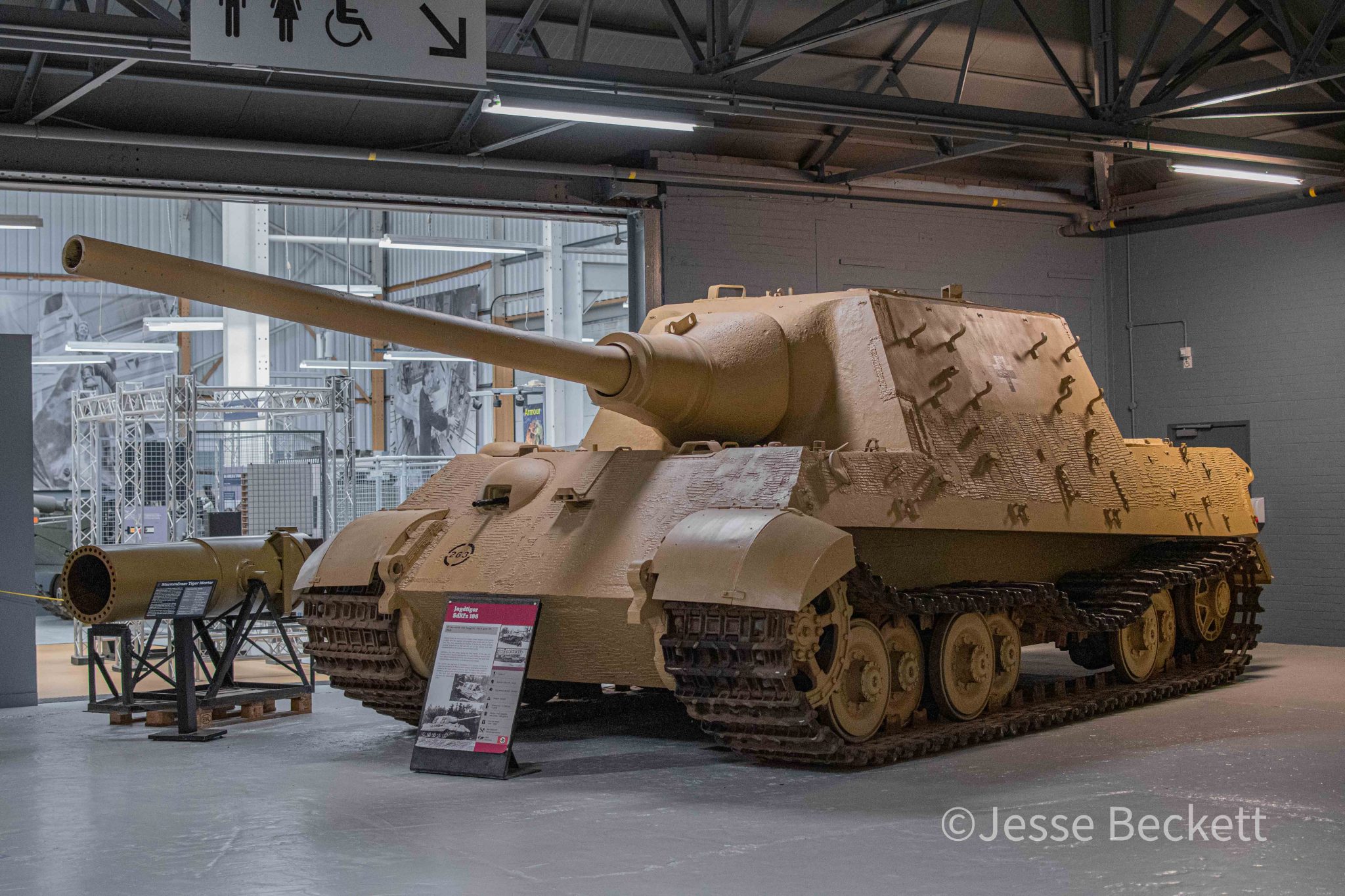
The World War Two menace, the Jagdtiger, earned two reputations during its short career from September 1944 to May 1945; one of a fearsome tank killing beast, capable of punching through any Allied tank at extreme ranges while immune to virtually everything on the battlefield, and one of a overweight, underpowered, cumbersome mobile bunker that would break down before it ever fired a shot.
Officially identified as the Sd.Kfz. 186 Panzerjäger Tiger Ausf. B, the Jagdtiger’s name translates to ‘Hunting Tiger’, as after all it was a tank destroyer built onto an enlarged Tiger II hull. Weighing almost 80 tons, the Jagdtiger was the heaviest armored fighting vehicle to reach operational status during the war.
Its 128 mm gun could blow a hole in any tank fielded during the war even at extreme ranges, and became the benchmark gun in deciding post-war tank armor protection. Simultaneously, its frontal armor, ranging from 100 mm to 250 mm, was virtually impervious to enemy fire.
In many cases a well dug in Jagdtiger was simply impossible to destroy with conventional weaponry, and required air support to put out of action.
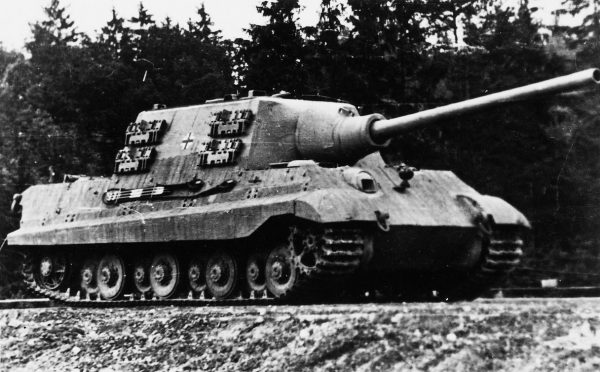
Why was a tank with these capabilities necessary?
Interestingly, the vehicle was originally conceived in 1942 as a heavy assault gun specifically to mount a 128 mm gun, that would move with the infantry, destroying fortifications while surviving the harsh incoming fire.
This task was no easy one, as it meant driving head on into powerful weapons, while being able to destroy heavily reinforced structures. To do this the vehicle needed a big gun, and lots of armor. Speed was not a priority. Similar vehicles were designed to tackle this role, like the Tortoise heavy assault tank (A39) and the T28 Super Heavy Tank, all featuring huge amounts of armor and powerful guns, while being painfully slow.
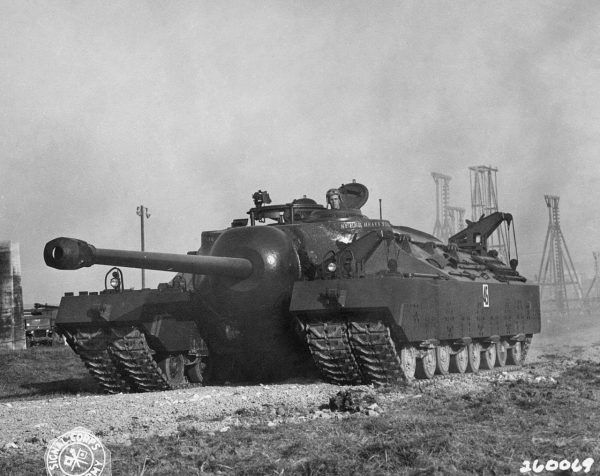
With this in mind, it becomes more understandable why the Jagdtiger’s mobility was so poor; it was not an oversight but in fact a design choice!
Between 1942 and mid 1943 much progress on this vehicle had been made. The linchpin to the entire design was the 128 mm armament, the same used by the Maus and modified for use in the Jagdtiger as the 12.8 cm Pak. 44 L/55. It was decided that this gun would not use a muzzle break, as it was intended to use sabot rounds.
Muzzle brakes cannot be used with these rounds as the detaching sabot can impact the device. The rounds offered some incredible penetration, but the gun produced far more recoil, needing more room inside the vehicle to operate. Ironically, these rounds never materialised.
From the start, the 128 mm gun was planned to be mounted on either a Panther or Tiger II chassis. But a mock-up of the gun on a Panther hull had proven that avenue to be unsuitable, so the Tiger II hull was chosen, a tank still being designed at the time.
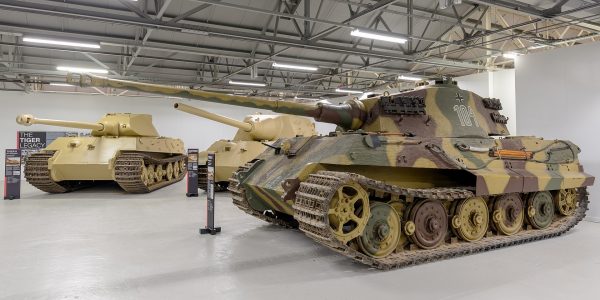
The 7 meter long gun weighed around 6 tons on its own, so to mount it along with ammunition, crew and engine onto a Tiger II, the already huge chassis had to be lengthened by 260 mm. Instead of a turret, the gun was mounted in a non traversable ‘casemate’ on top of the hull.
A casemate significantly simplifies design, and saves considerable amounts of weight. The drawback however is the gun has a limited arc of movement, which for the Jagdtiger was just 10 degrees either side and 7 degrees down, so the entire vehicle must rotate to point the gun outside of this arc.
The Jagdtiger had a crew of 6 men. The driver and radio operator were in the same positions as the Tiger II, the commander and gunner were located in the front right and left of the casemate respectively, and at the rear were two loaders keeping the gun fed. Two loaders were needed as the 128 mm gun used two-piece ammunition.
It was powered by the 700 hp Maybach HL 230 P30 TRM V12, the same engine used by the Tiger II and Panther, a tank 30 tons lighter, making the Jagdtiger very underpowered. Despite this, it could achieve a top speed of 21 mph, not bad for an 80 ton vehicle. In footage of the Jagdtiger, it is surprisingly nimble for its size and weight.
By September 1943 a full scale wooden mock-up had been built and was inspected by the German Army Ordnance Department, who recommended a few changes, including the removal of side firing ports, the gunners hatch, and an increase to the frontal superstructure thickness from 200 mm to 250 mm.
After these changes had been made, the mock-up was displayed to Hitler and his staff in October 1943. With Hitler’s weakness for large and intimidating looking vehicles, the Jagdtiger was ordered into production soon after.
Two prototypes began testing in February 1944, and production started in June that year. Eisenwerke Oberdonau iron works assembled the hulls, who then sent them bare to the Nibelungenwerk factory in Austria to be fitted and completed.
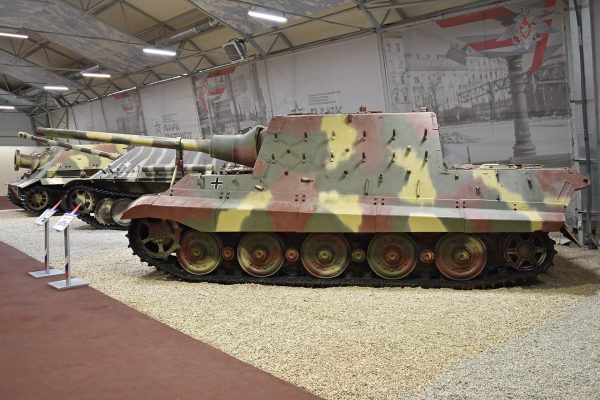
There was immediate trouble however, as the 128 mm gun and its cradle weren’t fitting correctly in the casemate, meaning in places up to 40 mm of armor had to removed inside to allow the gun to achieve its intended arc of movement. The cradle itself was too big too, meaning it had to be moved backwards to fit, but doing this then limited the gun depression to just 6.5 degrees.
These issues would be ironed out, but the biggest hurdle for its production was the supply of 128 mm guns, which were in desperately short supply due to a lack of raw materials and constant Allied bombing. By 1944’s end, just 50 Jagdtigers had been completed. Shockingly, in a bid to speed up production, it is reported that some crews were sent to factories to help complete their tank!
The supply of guns limited Jagdtiger production to only 75 in total, including prototypes, before Germany’s surrender in May 1945.
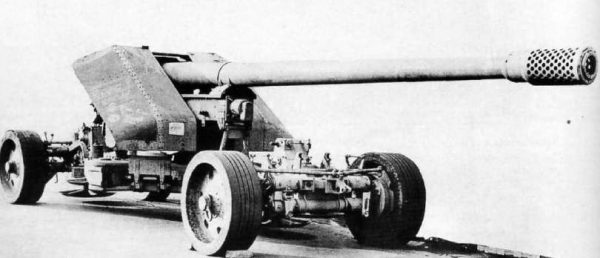
As mentioned before, the vehicle was first devised in 1942 when Germany was fighting an offensive war. At this point it was intended to be an assault gun, which is an offensive role. However by the time it was combat ready in 1944, the Germans were now on the defence, and the intended use of the Jagdtiger was now redundant. Instead, it would be employed as a defensive anti-tank platform.
This change of classification caused considerable debate amongst the German military, as a Sturmgeschütz (assault gun) would be used by the artillery branch, while a Panzerjäger (tank destroyer) would be used by the tank destroyer branch. The disagreement was settled by Heinz Guderian, who designated the vehicle a Panzerjäger in mid 1944.
The first Jagdtigers reached units in late 1944, and its fair to say their performance was rather underwhelming. The thirsty Maybach V12 struggled to propel them reliably, and their transmissions were similarly not up to the task.
As a result, breakdowns were frequent. One unit, s.Pz.Jg.Abt. 653, had just 2 out of their 33 Jagdtigers operational. Far more Jagdtigers were abandoned by their crews due to breakdowns or lack of fuel than by being knocked out by enemy guns.
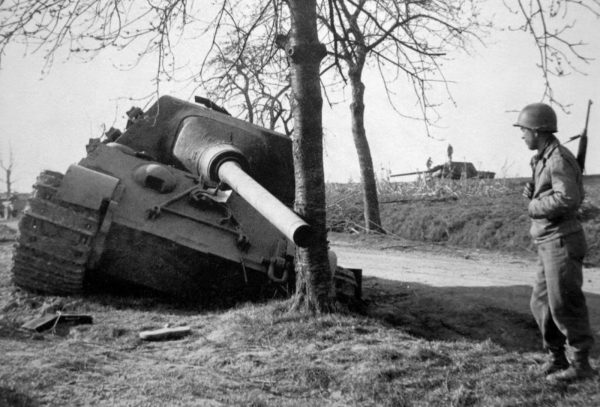
Other issues were encountered too, like the heavy main gun needing to be clamped down while travelling otherwise it would wobble out of alignment with the gun’s sights. This meant if a Jagdtiger was unexpectedly engaged, a crew member had to climb out the vehicle to unlock the gun while under fire. The need to rotate the entire vehicle to move the gun past 10 degrees sideways also added to the strain on the transmission.
Despite all this, in the ideal circumstances, the Jagdtiger was probably the most deadly vehicle of the war. Its 128 mm gun could tear tanks apart with terrifying precision, in one instance reportedly knocking out a Sherman almost 4,000 meters away.
Tank ace Otto Carius commanded a Jagdtiger during the final stages of the war, and shared his experiences in a book; Tigers in the Mud. In this book he recounts how a 128 mm round was fired through a house into an American tank behind it, knocking it out.
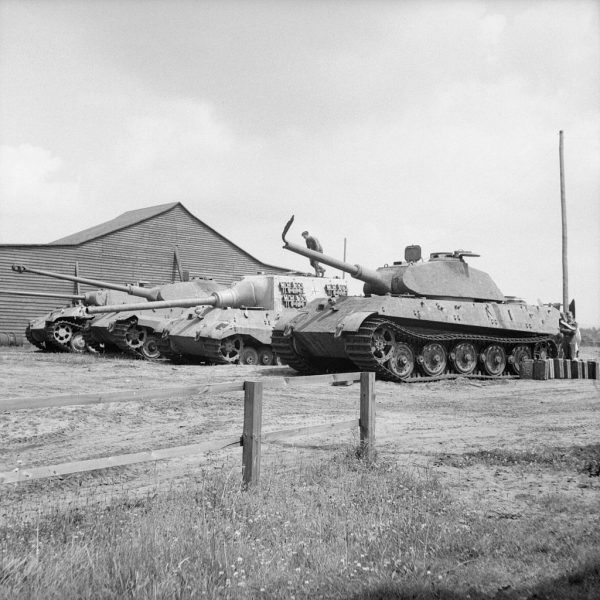
Overall, the Jagdtiger was an absolutely terrifying weapon of war, that gained an excellent kill-loss ratio from enemy fire. In perfect conditions nothing short of airpower or a naval shell would dig one of these machines out, but the problem is in war a weapon that only works in ‘perfect conditions’ isn’t a very useful one.
Another Article From Us: The Panzer IV – Germany’s Armored Workhorse
Inexperienced crews, a weak drive train and fuel shortages curtailed the Jagdtiger’s potential, and resulted in a machine of mind-blowing scale, but rather lacklustre performance.
